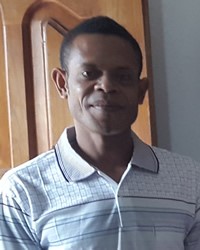Tewa, Lebang in Indonesia

Photo Source:
Anonymous
|
Send Joshua Project a map of this people group.
|
| People Name: | Tewa, Lebang |
| Country: | Indonesia |
| 10/40 Window: | Yes |
| Population: | 4,800 |
| World Population: | 4,800 |
| Primary Language: | Teiwa |
| Primary Religion: | Ethnic Religions |
| Christian Adherents: | 15.00 % |
| Evangelicals: | 3.00 % |
| Scripture: | Portions |
| Ministry Resources: | Yes |
| Jesus Film: | No |
| Audio Recordings: | Yes |
| People Cluster: | Flores-Sumba-Alor |
| Affinity Bloc: | Malay Peoples |
| Progress Level: |
|
Introduction / History
The Lebang Tewa, also known as the Tewa or Teiwa speakers of the Lebang dialect, are an indigenous Papuan ethnic group native to the rugged volcanic landscapes of Pantar Island in the Alor Archipelago, East Nusa Tenggara Province, Indonesia, primarily residing in the administrative villages of Lebang, Boweli, Kalib, Nule, Kadir, and Madar within Alor Regency.
Their name "Tewa" or "Teiwa" translates to "tree leaf" in the local tongue, symbolizing their deep-rooted connection to the island's forested highlands and coastal fringes, where clans have long thrived amid sago groves and coral bays. As part of the Timor-Alor-Pantar language family—debated as either Trans-New Guinea or a distinct isolate—the Lebang Tewa trace origins to ancient Papuan migrations from New Guinea around 40,000 years ago, settling Pantar's terraced slopes to form autonomous villages bound by kinship and ritual pacts against inter-island raids. Pre-colonial society centered on semi-nomadic horticulture and maritime trade, with oral epics recounting spirit-guided voyages across the Savu Sea and alliances like the ancient Hibua Lamo covenants that fostered harmony among Alor's diverse clans amid headhunting traditions and monsoon cycles.
The 16th century introduced Portuguese and Dutch colonial forays, with VOC traders exploiting sandalwood routes that integrated Lebang villages into tribute networks, introducing iron tools that reshaped swidden farming while sparking resistance through unified clan defenses.
By the 19th century, missionary influences from German and Dutch Protestants began eroding animistic strongholds, blending Christian ethics with ancestral lore; colonial consolidation imposed corvée labor for copra plantations, yet preserved adat governance.
Post-1949 independence, the Lebang Tewa navigated Indonesian integration amid transmigration and nickel mining booms, contributing to regional resilience during ethnic tensions while facing linguistic erosion from Alor Malay.
What Are Their Lives Like?
Today, centered in Lebang as the linguistic heartland, they embody Pantar's mosaic of ecological stewardship and cultural tenacity, with their tonal Teiwa dialect—featuring pharyngeal fricatives unique in eastern Indonesia—serving as a vital archive amid globalization's waves.
The Lebang Tewa navigate a verdant cadence of mist-veiled highlands and tidal shores on Pantar, where volcanic rains and lunar tides weave a tapestry of communal toil and mythic resonance, sustaining villages through adaptive harmony in East Nusa Tenggara's insular wilds. Work aligns with island pulses, as men terrace swidden plots for maize, taro, and bananas on nutrient-rich slopes or spearfish in reef shallows for tuna and octopus, while women process sago pith into flour and weave pandanus mats for barter at Kalabahi markets; families engage in rotating gotong royong labor exchanges for harvests, supplemented by seasonal wage labor in copra drying or eco-tourism guiding, blending subsistence ingenuity with tentative remittances.
Family dynamics root in bilateral clans clustered in elevated bamboo longhouses, where elders—adorned with shell talismans—convene hearth councils through gestured chants, marriages seal alliances via bride-service and gong exchanges evoking ancestral drifts, and child-rearing immerses youth in tonal lullabies and forest apprenticeships, with grandparents sharing guardianship to mirror the clan's fluid, leaf-like kinships. Celebrations surge with dry-season clarity, including initiation scars etched under full moons to invoke mountain guardians, harvest feasts with bamboo slit-gong ensembles and circular dances mimicking bird migrations, and mortuary vigils spanning dawns with effigy floats laden with sago offerings to guide souls seaward; inter-village gatherings revive Hibua Lamo oaths through mock raids and firelit narratives, affirming bonds in the humid gloam.
Food gleans Pantar's primal larder in earthy, shared rituals, centered on papeda—viscous sago gel swirled with fish broth and wild ferns—paired with smoked eel adobo, roasted cuscus for vitality, and fern tips in coconut milk; fermented sago sap quenches communal gourds during rites, portioned on nipa mats to echo the eternal rustle of tree leaves through village rhythms.
What Are Their Beliefs?
Lebang Tewas primarily adhere to ethnic religions rooted in animism, where spirits infuse volcanic peaks, sago hearts, and ancestral canoes, demanding ritual reciprocity through offerings and elder intercessions to secure monsoon yields and clan accord. This tradition permeates routines via highland shrines where kin invoke earth deities for planting wards, and melodic chants beseech sea shades amid gales, envisioning the landscape as a sentient kin lattice exacting equilibrium. Elders, as spirit bridges, enact pacts with unseen wardens akin to migration lore, intertwining ecological taboos with ethical mandates. At the same time, observances stress amends—offenses rectified via scarification or effigy immersions—perceiving life's surge as a sacred colloquy with the vital pulses of grove and swell.
What Are Their Needs?
Intensive orthographic development and audiovisual archiving for the Teiwa dialect are indispensable to capture its pharyngeal tones and oral epics before further dilution by Alor Malay in trade and schooling. Community patrols and legal advocacy for highland territories in Pantar would shield sago groves and fishing reefs from overharvesting and mining, preserving ceremonial loci and sustenance cycles. Solar-powered health outposts targeting tropical fevers and maternal nutrition would fortify resilience in remote hamlets, enabling deeper immersion in regency networks without severing island moorings.
Prayer Points
Pray for revelatory encounters among Lebang Tewa elders to discern Christ's dominion over mountain spirits, kindling longhouse assemblies that interlace migration tales with redemptive truths.
Pray that soon Lebang Tewa Christians will be teaching culturally-relavant ways to disciple.
Pray for resilient reforestation buffering villages from eruptions, yielding enduring sago and fin stocks for steadfast larders.